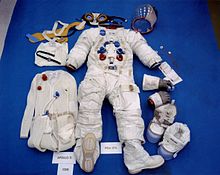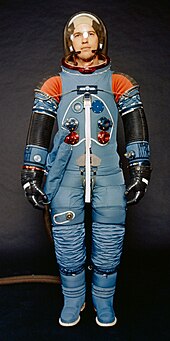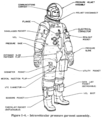A7L

The spacesuit A7L was developed by NASA - astronauts for the Apollo program , the three manned Skylab flights and the Apollo-Soyuz Test Project used from 1968 to 1975. Developed and manufactured by ILC Dover , it is based on their predecessor models A5L and A6L, which integrated thermal control and micrometeorite protection, and is considered to be the seventh spacesuit developed for the Apollo program. In addition, after the deadly fire of Apollo 1, a number of materials were replaced by flame-retardant or non-combustible ones.
construction
The A7L is a one-piece, essentially five-layer, full body suit with built-in rubber joints on the shoulders, elbows, wrists, hips and legs. The joints are reinforced with a mesh-like fabric in order to avoid inflation under the internal pressure and thus to maintain the astronaut's ability to move. There are metal rings on the neck and sleeve ends to which the helmet or gloves can be attached; the shoes, on the other hand, are an integral part of the suit. The helmet, jokingly referred to as the “ fish bowl ”, is made from one piece of Plexiglas and not only allows a better view than previous models, but also eliminates the otherwise necessary seals and is therefore more reliable. The outer, fireproof layer of the suit is removable and allows repairs and inspections. Entry is from the back / below through a zipper that runs from the shoulder to the crotch. It can be operated by the wearer himself, but the help of another person still makes it much easier to put on and take off.
Specifications
- Title: spacesuit Apollo A7L
- Manufacturer: International Latex Corporation (ILC) (suit), Dover and Hamilton Standard (life support system)
- Missions: Apollo 7 to Apollo 14
- Function: Working inside (IVA) or outside ( EVA ) the vehicle
- Internal pressure: 25.5 kPa, pure oxygen
- Mass (IVA): 28.1 kg
- Weight (EVA): 34.5 kg
- Total mass including life support system: 83 kg
- Autonomy: 6 hours
- Emergency system: 30 minutes
Carrying method for EVA
The most important location was the Torso Limb Suit Assembly . The supply of oxygen and cooling water as well as the electrical connection for the headset and the biodata were made via six color-coded bayonet connectors that were attached in two rows on the chest. Gas inlets and outlets were duplicated, allowing the astronauts to connect to their portable life support systems while they were still connected to the vehicle (CM or Lunar Module).
Over this layer was the thermal and micrometeorite protection Integrated Thermal Micrometeroid Garment , which protected the suit and its wearer from abrasion, solar radiation and micrometeorites. It consisted of a total of 13 layers of nylon, aluminum-coated Mylar, Dacron, Kapton and an outer layer of Teflon-coated beta fabric. This beta fabric essentially consisted of glass fibers and provided the desired fire resistance. Critical areas on the back, the overboots and gloves required for the moon were reinforced with steel mesh and knees and shoulders were additionally covered with Teflon.
Starting with Apollo 13 , additional red stripes were attached to the helmets and legs of the commander in order to better identify the two astronauts in photos.
The astronauts working on the moon wore a special cooling device as the innermost layer, the three-layer Liquid Cooling Garment . Inside, water hoses were incorporated to cool the astronaut and prevent sweat and fogging of the helmet. The water was pumped through the suit by the life support system and kept at temperature by a sublimation cooler . These suits also had outside pockets for lunar rocks and equipment as well as tabs to be able to fix themselves in the lunar module.
Carrying method for IVA
The pilot of the CM wore a slightly simplified suit that eliminated some of the connectors and joints of the Torso Limb Suit Assembly . On top of that he wore a three-layer intravehicular cover layer made of Nomex and Beta fabric, and the outer cover was a layer of cotton fabric ( Constant Wear Garment ). Cooling was done directly by the oxygen coming from the spacecraft's systems.
A7LB spacesuit (Apollo, Skylab and ASTP)
Apollo 15-17
For the last three lunar flights, Apollo 15 , Apollo 16 and Apollo 17 , the two astronauts on the moon used a further development of this suit. In particular, the mobility of the neck and hips has been improved, enabling the astronauts to drive the Lunar Roving Vehicle (LRV) in a sitting position. Connections and zip were changed and made easier to use.
The portable life support systems ( knapsacks ) received larger tanks for oxygen and cooling water, additional lithium hydroxide for separating the carbon dioxide and reinforced batteries. Small energy bars and straws were attached to the inside of the helmet so that the astronauts could strengthen themselves during their stay on the lunar surface.
The suit of the CM pilot, whose job included the recovery of films from the SM during the return flight, was still based on the A7L and was supplied and cooled from the CM during this EVA. He was wearing the commandant's helmet.
Specifications
- Designation: Apollo A7LB spacesuit
- Manufacturer: International Latex Corporation (ILC) (suit), Dover and Hamilton Standard (life support system)
- Missions: Apollo 15 to Apollo 17
- Function: Working inside (IVA) or outside (EVA) the vehicle
- Internal pressure: 25.5 kPa, pure oxygen
- Mass (IVA): 29.3 kg
- Mass (EVA): 35.4 kg
- Total mass including life support system: 90.7 kg
- Autonomy: 7 hours
- Emergency system: 30 minutes
Skylab
For the three manned Skylab missions, simplified suits based on the A7LB were used, as only short EVAs were expected for maintenance purposes. To protect Skylab's optical instruments, the life support used on the moon was replaced by a closed circuit that was connected to the space station's breathing air and cooling systems. The astronauts were therefore connected to Skylab via an umbilical cord and only carried an emergency system with oxygen for 30 minutes on their right leg.
Specifications
- Description: Space suit Apollo A7LB for Skylab
- Missions: Skylab 2 to Skylab 4
- Mass (EVA): 32.7 kg
- Total mass including life support system: 64.9 kg
- Life support: through space station
- Emergency system: 30 minutes
ASTP
A simplified version of the A7LB was also used for ASTP , as no EVAs were provided.
Specifications
- Description: Space suit Apollo A7LB for ASTP
- Missions: ASTP
- Mass (IVA): 29.3 kg
- Life support: by spacecraft
- Emergency system: none
Life support system
The portable life support system ( Portable Life Support System, PLSS ) for staying on the moon was constructed in the form of a knapsack. It supplied its wearer with oxygen and cooling water, regulated the pressure of the suit, removed the carbon dioxide from the air he breathed and enabled a radiotelephone connection. Some of the water was lost in the process. It was operated via a small console on the astronaut's chest. Water and oxygen could be replenished several times from the spacecraft's systems. The emergency system ( Oxygen Purge System ), which held oxygen in an open circuit for 30 minutes, was attached to the top. It never had to be used.
The devices were no longer needed for the return flight and remained on the moon, as did the overboots, gloves and other equipment.
Specifications
- Name: Apollo PLSS
- Dimensions: 66 cm high, 46 cm wide, 25 cm deep
- Weight (empty): 38 kg
-
Consumables:
- Oxygen below 7.0 MPa for 4 h (below 10.0 MPa for 8 h for the J missions)
- 1.4 kg (1.42 kg) lithium hydroxide
- 3.9 l (5.2 l) cooling water
- Batteries with 279 Wh (390 Wh)
Web links
- NASA JSC Oral History Project Walking to Olympus: An EVA Chronology PDF document.
- Apollo Operations Handbook Extravehicular Mobility Unit: Volume I: System Description: Apollo 14 (PDF; 4.4 MB)
- Apollo Extravehicular mobility unit. Volume 1: System description - 1971 (PDF document; 4.6 MB)
- Apollo Extravehicular mobility unit. Volume 2: Operational procedures - 1971 (PDF document; 3.8 MB)
- Skylab Extravehicular Activity Development Report - 1974 (PDF document; 20.6 MB)
- A history of NASA space suits (PDF; 1.3 MB)
- APOLLO EXPERIENCE REPORT DEVELOPMENT OF THE EXTRAVEHICULAR MOBILITY (PDF Document; 9.0 MB)
- A visual history of project Apollo including many space suit photographs
- ILC Spacesuits & Related Products (PDF; 13.1 MB)
Individual evidence
- ↑ Science Friday Archives: How to Dress for Space Travel . In: NPR , March 25, 2011. Archived from the original on October 10, 2011. Retrieved on September 18, 2013.
- ↑ SP-4011: Skylab A Chronology . NASA . 1977. Archived from the original on July 17, 2007. Retrieved July 7, 2007.
- ^ Charles Lutz, Harley L. Stutesman, Maurice A. Carson, and James W. McBarron II: EMU Development . In: Development of the Extravehicular Mobility Unit - pages 22-26 . NASA. 1975. Archived from the original on August 1, 2007. Retrieved July 8, 2007.
- ↑ , Kenneth S. Thomas & Harold J. McMann US Spacesuits . Praxis Publishing Ltd., Chichester, UK 2006, ISBN 0-387-27919-9 , p. 32.
- ↑ a b NASA: Advanced Life Support. Baseline Values and Assumptions Document: JSC 47804 ( Memento of October 13, 2006 in the Internet Archive ) (PDF, 4.8 MB, English), page 85, table 5.2.3
- ^ Commander's Stripes . In: Apollo Lunar Surface Journal . NASA. Retrieved September 18, 2013.
- ^ Charles Lutz, Harley L. Stutesman, Maurice A. Carson, and James W. McBarron II: EMU Development . In: Development of the Extravehicular Mobility Unit - pages 28-29 . NASA. 1975. Archived from the original on August 1, 2007. Retrieved July 8, 2007.
- ^ Charles Lutz, Harley L. Stutesman, Maurice A. Carson, and James W. McBarron II: EMU Development . In: Development of the Extravehicular Mobility Unit - pages 43-44 . NASA. 1975. Archived from the original on August 1, 2007. Retrieved July 8, 2007.
- ↑ Space Suite Evolution (PDF; 1.3 MB) In: Space Suit Evolution - page 22 . NASA. 1975. Retrieved July 9, 2007.
- ↑ Apollo ASTP Press Kit (PDF) In: Apollo ASTP Press Kit pages 52-53 . National Aeronautics and Space Administration . 1975. Retrieved December 1, 2013.







